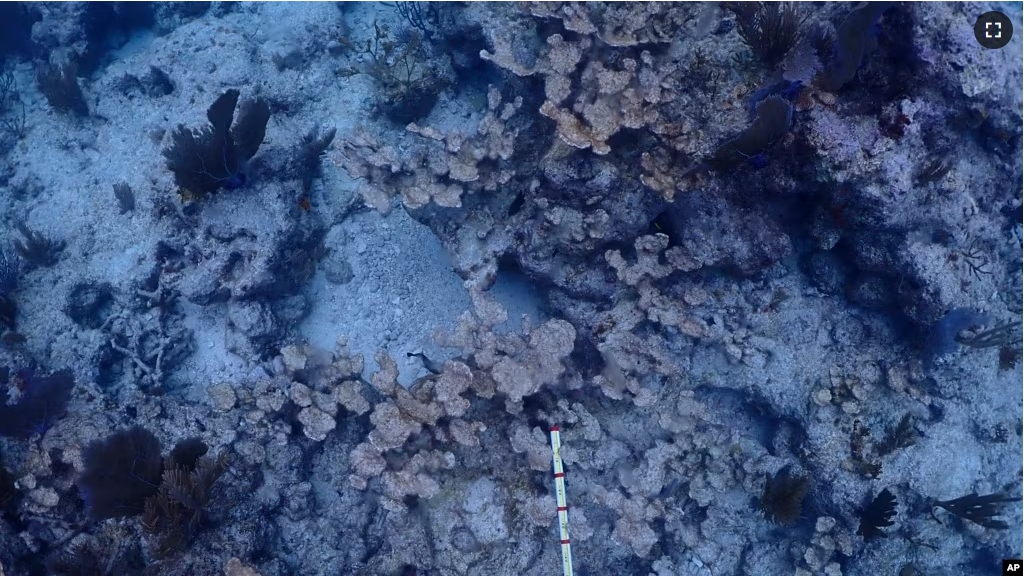Government scientists are aiming to replace coral at seven places off the Florida Keys island group. But The Associated Press reports three fourths of the newly cultivated coral has died because of warm water temperatures.
The scientists are with the U.S. agency known as the National Oceanic and Atmospheric Administration, or NOAA. They planted staghorn and elkhorn coral as part of the agency’s Mission: Iconic Reefs effort, first announced in 2019. The corals are being grown on structures in shallow water.
The two species of coral are considered threatened. The scientists wanted to see how the cultivated species were doing. They visited five places where they had planted coral earlier. They hoped the coral had survived water temperatures reaching 30 degrees Celsius or more during the summer and fall.
Last summer, students and volunteers tried to rescue the corals by removing them and temporarily putting them in tanks.
But most of the coral did not survive. NOAA said only 22 percent of the 1,500 repopulated staghorn corals that they saw were still alive. Only five percent of 1,000 replanted elkhorn corals were alive. At Looe Key, the southernmost of the reefs they looked at, “we did not find any live elkhorn or staghorn coral, not wild, not planted,” said coral biologist Katey Lesneski. She is research and monitoring coordinator for NOAA’s effort.
“It’s really horrible to witness,” Lesneski said just two days after the dives to observe coral had finished.
Scientists blame human-caused climate change. They also note that the natural El Nino Pacific Ocean current affects weather in North America. They said these conditions are making the water too warm for the coral. Corals are small animal colonies that build rocky formations as they grow.
“There’s still a lot of data to be collected to really understand…” Lesneski said. She added: “But we certainly have not seen something like this in recorded human history.”
Staghorn and elkhorn populations are important because they provide a “structural framework” for coral, Lesneski said.
The scientists did see some wild coral alive and well, she said. Brain or boulder corals seemed to be doing better.
The U.S. government and private groups plan to spend at least $97 million to place coral species grown on land or in the ocean in seven places off the Florida Keys the AP reports. Some of the species are native and others have been crossbred to be heartier, Lesneski said. It is too early to tell which ones are better able to survive.
Lesneski said NOAA measured water temperatures of 34 degrees Celsius at the planting places. Mark Eakin is with the International Coral Reef Society. He said, “They were actually seeing temperatures that they didn’t think were possible.”
Eakin and the University of Victoria coral biologist Julia Baum said the findings raise concerns about trying to repopulate coral reefs by cultivating coral in very warm water.
Lesneski said she understands that concern and researchers are looking to see what they could do to breed more heat-resistant coral.
“But for now, if we want to have…reefs, we do have to do our best to conserve, be good stewards and restore to the degree we can,” she said.
I’m Dan Novak.
Dan Novak adapted this story for VOA Learning English based on reporting by The Associated Press.
_______________________________________________
Words in This Story
coral –n. a simple sea animal that forms colonies which build up rocky structures of great size under the sea
cultivate — v. to raise, care for and develop something like a living thing
species –n. (sing., pl.) a kind of animal or plant that can breed with others of its kind to produce young
monitor –v. to carefully observe and measure the development of a living thing or of some activity
crossbreed — v. to breed two different but related kinds of animals together to form a new kind
hearty — adj. healthy and strong
breed — v. to cause a kind of animal to reproduce especially with the idea that the offspring will have certain qualities
conserve — v. to preserve things so that they last into the future in good condition and are not used up
steward — n. a person who oversees and protects property and is responsible for it
